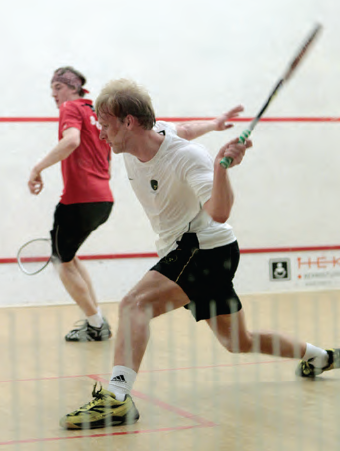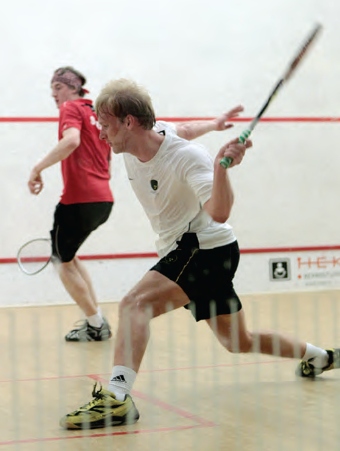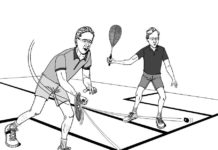By Barry Faguy, WSF Referees and Rules Committee
Nope—we ain’t talkin’ ‘bout cussin’ this time round. We’re talking about what you should or should not say to players to explain your decisions when you’re in the Referee’s chair.
Introduction

Although it’s often heard that Referees should not explain decisions, the rules allow for it. It’s true that many times a complaining player is simply being obnoxious, or looking for a break in the action—but many times, a player honestly wants to know. Explanations can often make your standards clear, help defuse aggression, and demonstrate that you understand what’s going on. Unfortunately, incorrectly worded, they can demonstrate that you don’t!
It’s not exaggerating to claim that well over half of Referee explanations are either flat-out wrong, incomplete, or nonsensical (which is the origin of that suggestion above about keeping your mouth shut). If you’re going to say something, it’s got to make sense and be consistent with the rules—otherwise it fails to be of any use, or fails to defuse any pent up aggression, or can simply be embarrassing. Giving relevant and rational explanations demonstrates that you know the principles involved. With that in mind, let’s look at some typical scenarios.
Regarding the swing
First, we need to understand a few things about the swing (dealt with extensively in past articles). The swing is a very sensitive motion, and any interference to it virtually always has a dramatic consequence in terms of where the ball goes— so we can’t use that last fact as a clue to the right decision, or its explanation. The ‘swing’ rule is actually about the amount of interference (minor or major—affected or prevented), so it’s an error to hold that all racquet contacts are Strokes.
The proper rules-based interpretation of swing-related interference is that if it is major (“prevented”), it’s always a stroke. If it’s minor (“affected”), then the opponent’s clearing effort is the determining factor (i.e., good clearing? Yes Let; Poor clearing? Stroke).
Given that, if you are awarding a Stroke against someone for swing interference, you should never explain it simply with: “The racket hit you” or “You were in the swing.” Those conditions are obvious to all and stating them is useless. Those words simply do not give enough information since they make no distinction regarding the amount of swing interference, nor do they refer to the clearing effort, if it’s a consideration.
What you can accurately say to justify a Stroke is something like: “You prevented your opponent’s swing” or “That was minor contact, but your clearing effort was poor.” To justify a Let, you could say: “Yes, there was racket contact, but it was minor and your opponent was making a good clearing effort.”
Regarding ‘Wrong-footing’
Again, we need to look at a few basics here. Wrong-footing occurs when the striker is fooled, and mistakenly takes a wrong route to the ball. Typically, during the recovery effort, the opponent (who originally had provided direct access) winds up being in the way. It’s a very common occurrence, and there’s nothing inherently bad about it; in fact, the rules allow for it. It is by itself, a neutral occurrence in terms of decision making.
Given that, it is an error to explain a ‘No Let’ solely with: “You went the wrong way.” The fact that a player mistakenly went the wrong way is totally immaterial to your decision. What the rules really require you to determine is whether the striker could have recovered to play the ball—and whether every effort was made to do so. It’s also an error to justify a No Let for wrong footing by making a statement like: “You created that interference.” Wrong-footing clearly is not ‘created interference’. (See last month’s article on ‘Cheating’.)
On the other hand, a couple of acceptable explanations for the No Let would be: “You could not have reached the ball” or “You did not make every effort to recover and play the ball.”
Regarding ‘ball’ interference
We’re talking now about the potential for the opponent to be hit by the ball on its path to the front wall. ‘Crossing the flight’ or ‘Danger zone’ are the colloquial expressions that Referees use to refer to the concept.
Given that the rules simply ask if the opponent would have been hit or not by the ball going directly to the front wall, it would be a mistake to explain a Stroke with a statement like: “You made no effort to clear” or “You didn’t move”—since any effort to clear is immaterial. These rules (9.1.1 or 12.8.4) are ‘all or none’ rules. The opponent is in the way or not.
On the other hand, acceptable explanations could be:
For an actual hit: “The ball was going directly to the front wall.”
For the striker refraining: “The ball would have hit you while going directly to the front wall.”





